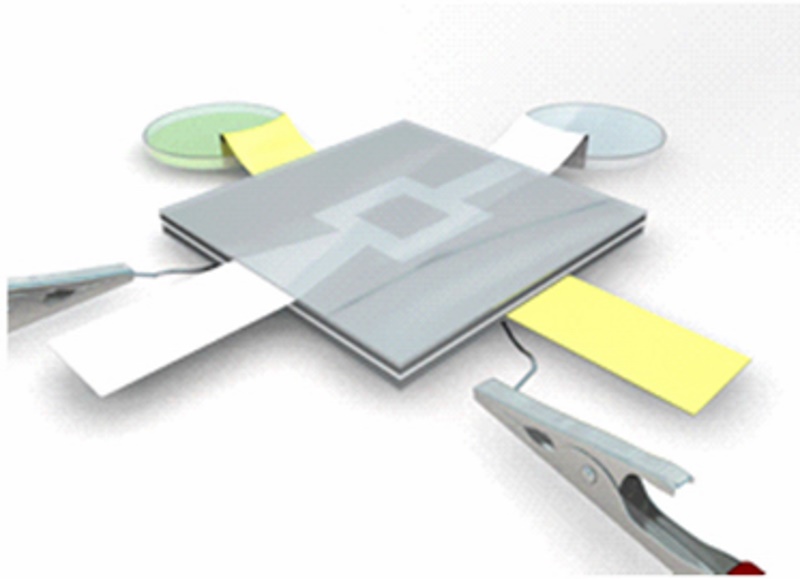- Home
- Science
- Science News
- New 3D Paper Based Microbial Fuel Cell Developed
New 3D Paper-Based Microbial Fuel Cell Developed

Researchers from the Iowa State University in the US demonstrated a proof-of-concept three-dimensional microbial fuel cell (MFC) that could take advantage of capillary action to guide the liquids through the MFC system and to eliminate the need for external power.
The paper-based MFC runs for five days and shows the production of current as a result of biofilm formation on anode.
The system produces 1.3 micro Watts of power and 52.25 micro Amperes of current.
"All power created in this device is useable because no electricity is needed to run the fluids through the device. This is crucial in the advancement of these devices and the expansion of their applications," said Nastaran Hashemi, assistant professor at Iowa State.
The biofilm formation on the carbon cloth during the test provides further evidence that the current measured was the result of the bio-chemical reaction taking place.
This is important because the biofilm plays a vital role in current production of a microbial fuel cell. Increased biofilm size and thickness ultimately leads to increased current production.
Individual bacterial cells metabolise electron-rich substances in a complex process involving many enzyme-catalysed reactions.
The electrons are then free to travel to the anode through one of many modes of electron transport.
Electron transport is very complicated, and evidence suggests that it is unique to each type of bacteria. For the bacteria Shewanella Oneidensis MR-1, the most predominantly known ways of shuttling electrons from the individual cells to the anode are through direct contact, excreted soluble redox molecules, and biological nanowires.
Of these, it is widely believed that excreted soluble redox molecules serving as extracellular electron shuttles makes up for as much as 70 percent of electron transfer mechanisms from individual bacterial cells to the electrode.
Moreover, it is shown that direct contact between individual S Oneidensis MR-1 and the electrode has little impact on the current generation, supporting a mediated electron transfer mechanism.
Biofilm helps with the adsorption of the redox molecules to the electrode, which makes it important to have in high power density microbial fuel cells.
Without enough time for biofilm to form, the current and power data would predominantly be linked to extracellular electron transfer, which represents does not fully represent electrical producing capabilities of microbial fuel cells.
This device for the first time demonstrates the longer duration of use and ability to operate individually, a development that could help increase the number of situations where microbial fuel cells can be applied.
The study was published in the journal Technology.
Catch the latest from the Consumer Electronics Show on Gadgets 360, at our CES 2026 hub.
Related Stories
- Samsung Galaxy Unpacked 2025
- ChatGPT
- Redmi Note 14 Pro+
- iPhone 16
- Apple Vision Pro
- Oneplus 12
- OnePlus Nord CE 3 Lite 5G
- iPhone 13
- Xiaomi 14 Pro
- Oppo Find N3
- Tecno Spark Go (2023)
- Realme V30
- Best Phones Under 25000
- Samsung Galaxy S24 Series
- Cryptocurrency
- iQoo 12
- Samsung Galaxy S24 Ultra
- Giottus
- Samsung Galaxy Z Flip 5
- Apple 'Scary Fast'
- Housefull 5
- GoPro Hero 12 Black Review
- Invincible Season 2
- JioGlass
- HD Ready TV
- Laptop Under 50000
- Smartwatch Under 10000
- Latest Mobile Phones
- Compare Phones
- Honor Win RT
- Honor Win
- Xiaomi 17 Ultra Leica Edition
- Xiaomi 17 Ultra
- Huawei Nova 15
- Huawei Nova 15 Pro
- Huawei Nova 15 Ultra
- OnePlus 15R
- Asus ProArt P16
- MacBook Pro 14-inch (M5, 2025)
- OPPO Pad Air 5
- Huawei MatePad 11.5 (2026)
- Xiaomi Watch 5
- Huawei Watch 10th Anniversary Edition
- Acerpure Nitro Z Series 100-inch QLED TV
- Samsung 43 Inch LED Ultra HD (4K) Smart TV (UA43UE81AFULXL)
- Asus ROG Ally
- Nintendo Switch Lite
- Haier 1.6 Ton 5 Star Inverter Split AC (HSU19G-MZAID5BN-INV)
- Haier 1.6 Ton 5 Star Inverter Split AC (HSU19G-MZAIM5BN-INV)

















